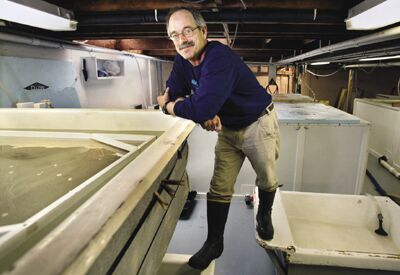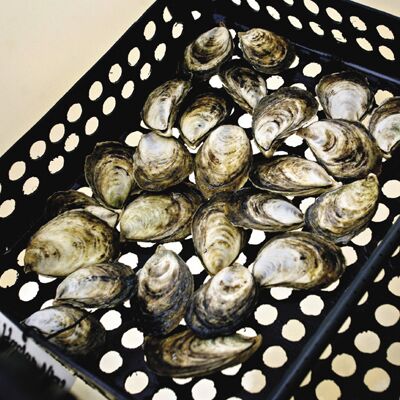Maine's oyster heartland battles an outbreak to protect its ‘blue ribbon' product
There's just something about the American oysters that are growing in the Damariscotta River area. Maybe it's the way the cold waters of the Atlantic mingle with the shallow, warmer water upstream. Maybe it's the health of the clean estuaries thanks to the lack of foul storm-water runoff.
Whatever it is, Maine oysters are considered some of the best in North America, according to one cultured expert.
Oyster connoisseur and author Rowan Jacobsen, a Florida native now living in Vermont, says Maine has the best reputation for oysters than any other state on the East Coast. He believes the cold water, which slows the growing cycle, creates an oyster with a better texture and a more briny taste.
"In my experience, Maine oysters are always clean and light in flavor, with none of the low-tide funkiness you sometimes find in warmer-water oysters," says Jacobsen. "And they are almost always extremely briny."
Jacobsen is the author of "A Geography of Oysters: The Connoisseur's Guide to Oyster Eating in North America." In it, he says the taste of oysters — unlike lobsters, scallops, mussels and other seafood — are a direct reflection of the environment in which they're grown.
In 2010 (the most recent figures available), Maine's oyster harvest was a $1.8 million industry. In 2008, the industry was valued at more than $2 million. Out of the nearly three million oysters harvested 2010, more than 72%, or 2.14 million oysters, were pulled from the Damariscotta River area.
But now that industry is being threatened by a fatal pathogen, known as MSX. And for some oyster harvesters, some of whom have reported losses of 80% or more, the timing couldn't be worse.
Shellfish under siege
In recent years, Maine has received favorable coverage of its oyster industry, including a 2009 write-up in the New York Times travel section, "Where Maine Comes Out of Its Other Shell."
On a per-acre basis, oysters are second only to salmon as the most valuable agricultural "crop," according to the Maine Aquaculture Association.
Dana Morse, an extension associate at the Sea Grant and the University of Maine's Cooperative Extension, says Maine oysters are considered a "blue ribbon" product, often fetching some of the highest per-piece prices on the East and Gulf coasts.
The industry, he says, is attracting more growers, including commercial fishermen who are either using oyster growing to supplement incomes, or are completely giving up commercial fishing for aquaculture. Growers are even setting up farms outside of Damariscotta, Maine's oyster heartland, Morse says, noting new farms in Penobscot, Hancock and Cumberland counties.
"The quality name of all of the oyster farmers in the state is essentially a blue-ribbon item," Morse says. "It's because it's a beautiful oyster. It looks great. It tastes great."
Morse says the timing of the current MSX outbreak is unfortunate, biting into the supply of a Maine product that is in high demand, both locally and at upscale restaurants in big cities.
MSX is caused by a protozoan that first infects the oyster's gill tissue, inhibiting breathing, feeding and ultimately reproduction. MSX is not dangerous to humans, but it can be fatal to oysters, Morse says.
MSX was first observed in Delaware Bay in 1975, but can now be found from Maine to Florida, according to UMaine. It typically thrives in warmer water with low salinity.
Morse says this is not the first time Maine has dealt with MSX. But the current outbreak in Damariscotta, where between two-thirds and three-quarters of Maine's oysters are grown, seems to be "a different and more virulent strain."
"It's a big deal," says Morse, "but it's not the end of the world."
Morse says many oyster growers have switched to disease-resistant strains. Although it's unclear exactly how MSX spreads, the Maine Department of Marine Resources has also instituted bio-security measures, such as prohibiting the transfer of oysters from Damariscotta to other parts of the coast, to prevent the outbreak from spreading.
While the outbreak is causing short-term hardship for many oyster growers, Morse says the industry could emerge stronger than ever.
"In the long run, it might be a good thing," he says. "Any farmer wants to prevent the spread of disease. This helps to keep people focused on good animal health, good husbandry, that kind of thing."
Eating the losses
Barbara Scully is the owner of Glidden Point Oysters, which was the subject of the New York Times feature in 2009. Her oysters were also featured on Jacobsen's list of "A Dozen Oysters You Should Know."
Like many oyster growers, Glidden Point, which has two full-time and six to eight part-time employees to tend to its 28-acre operation, was hit hard last year by MSX. Scully says she lost around 80% of her harvest to the disease.
"Eighty-percent mortality is a big number," Scully says. "There have been bumps in the road, but this is a mountain."
Scully grows her oysters for a year in suspension equipment before planting them on the ground, where they grow an additional two years. Bottom cultivation, she says, allows her oysters to develop a stronger, better-shaped shell.
Scully says even during a typical year, she can only count on harvesting about half of the oysters she plants, which makes MSX even more devastating.
To make ends meet, Scully says she sold more lobster, clams and periwinkles to generate income. But she also had to increase her prices last year to stem her losses. She says wholesalers, which distribute her oysters to upscale restaurants in major U.S. cities and in Canada, bore the brunt, with their prices increasing by 20%.
While local retailers and restaurants only saw their prices increase by less than 10%, Scully says they will likely see the bigger increase this year. The size of this year's price increase is still being calculated, she says.
One thing is for sure: customers need to expect to pay a little more for quality oysters. Scully says she hopes that her top customers will understand the reason prices are increasing and stay with her. "You have to explain to people what you're doing — that it's not greed driven; it's need driven," she says. "And hopefully it's temporary."
Scully says she began growing a line of disease-resistant oysters last year, a switch she says that increased her seed budget by about 35%. Even then, the disease-resistant crop will not be ready to harvest until 2013.
Scully says she is also looking at ways to better utilize her 28 acres of ocean bottom by using more equipment to spread out her oysters in their first year before being planted on the bottom.
Overall, Scully is buoyed by making ends meet last year.
"That's as bad as it's going to get and I made it," Scully says with an air of triumph and perseverance. "I expect to crawl out of this."
Building better seeds
Nearly a decade ago, Bill Mook had some free time on his hands, so he decided to read a report about climate change put out by the Clinton administration. The report, which identified climate impacts by geographical region, set him to thinking about what could happen to Maine's oyster populations should ocean temperatures rise in the Northeast.
Mook, who operates Mook Sea Farm, one of two oyster hatcheries in the state, immediately became worried about challenges faced by Mid-Atlantic states, particularly the threat of MSX. At the time, it was believed that Maine's long winters and cold waters were enough to keep the parasite at bay, but last year that was disproven.
"We were concerned the disease would rear its ugly head here, because of things going on climatically," Mook says. "I decided we needed to start thinking about what we want to do to counter that. It seemed to be a pretty sure bet the disease would end up here."
At the time, Mook says Rutgers University and Virginia Institute for Marine Science had already been working on disease-resistant strains. A seed supplier to affected areas, Mook Sea Farms began its disease-resistant spawning operation about seven years ago. Mook says his hatchery operation is essentially quarantined from the natural ocean and river water.
Before the MSX outbreak, Mook says about 70% of the 50-60 million seeds at his hatchery were disease resistant. Now it's more than 90%. Non-resistant strains can cost $6 per 1,000, while disease-resistant strains cost between $10 and $12 per 1,000. But Mook says that additional money doesn't go into his pocket. Instead, he must pay royalties to two companies that provide the disease-resistant brood stock and have patents on the spawning technology.
Ironically, the oysters harvested last year by Mook were mostly non-disease resistant, so he lost about 80% of the harvest. But Mook says he expects to harvest his first big batch of disease-resistant oysters in 2013.
Unlike Scully, Mook grows his oysters in suspension cages instead of on the ocean bottom, allowing him harvest more than 90% of his oysters. Suspended oyster cultures also allow his oysters to grow faster, harvesting after two years as opposed to three, which also protects his oysters from succumbing to MSX, he says.
"This year we will be selling more than we used to sell," he says.
Mook says he increased his wholesale prices last year by roughly 5%, which he believes was slightly below the market average.
Better days ahead
Many experts agree that the future of Maine's oyster industry remains bright. And the recent MSX outbreak hasn't discouraged people from seeking licenses for new or expanded oyster farms, which are spreading beyond the Damariscotta River area.
As of Feb. 23, nine oyster-growing leases were pending before the Maine Department of Marine Resources. Marcy Nelson, an aquaculture marine scientist, says the regulatory review of proposed grow sites can take a year or more, depending on the location. Growers must pay a $1,500 application fee for a standard, 10-year lease for up to 100 acres of ocean bottom and pay an additional $100 per acre annually.
David Cheney is among the new oyster farmer applicants. The longtime lobsterman recently sold his lobster boat to invest in his oyster enterprise. "I see the lobster industry as biologically strong," says Cheney, "but economically, it's upside down."
Cheney says when he started lobstering 15 years ago, a bushel of bait cost $2, a lobster trap cost $46 and diesel was a low 57 cents a gallon. Today, each product costs $9, $73 and $3.87, respectively. While a record number of lobsters were hauled in from the Maine waters last year, the prices off the boat were too low for Cheney to make ends meet, especially after paying his sternman. "It's disheartening," he says.
Since 2007, Cheney has been growing oysters in the Johns River in Lincoln County on a small scale as part of the state's experimental leasing program, which involves less red tape and lower costs than the standard 10-year leases. Johns River oysters are sold to Portland wholesalers like Harbor Fish Market and Brown Trading Co., who in turn sell them to restaurants.
While the price of lobsters and clams varies from year to year, Cheney says oyster prices are consistent and the demand for Maine oysters continues to grow. Aquaculture gives him more control over his own destiny, he says.
"People who like oysters are almost obsessed with them," says Cheney. "Each company, or brand name, is like a winery — there's a unique taste. … You almost have a cult following, where people get used to Johns River Colonial Cocktails and they ask for them by name."
MSX isn't enough to scare away Cheney. The disease only had a minimal presence in the Johns River, he says, claiming only 10% of his small operation. He plans to double his 2012 seed order from 200,000 seeds to 400,000 seeds.
Like others in the region, he is now growing disease-resistant seeds, which he gets from the Muscongus Bay Aquaculture in nearby Bremen, and he is optimistic about the future of oyster growing despite the MSX outbreak.
"It's not about what you're making this month or this year; it's about the future," says Cheney, who is also a clam digger.
Longtime oyster growers like Mook and Scully are optimistic, too.
Mook says only 50% percent of his income has come from his oyster-growing operation, but he is ramping up that side of his business. He currently has an application before the DMR to add 27 acres for suspension cultures, in addition to the five acres he currently leases. "In 2012 we expect to sell double of what we sold in 2011 – but that's above and beyond what we did before," he says.
Scully says MSX has forced her to re-examine all aspects of her business, from the types of oyster seeds to costs of shipping supplies. "In the end it will make me a stronger company," she says.
Read more














Comments